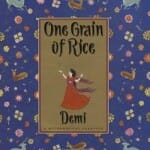 I looked at the book cover. I looked again. What did the title of the book, One Grain of Rice: A Mathematical Folktale, have in common with flowers, deer, and an Indian woman? The illustrator and writer, Demi, did not provide any clues about the content of the book. Yet, I was intrigued because I was already familiar with this talented illustrator and author who once lived in India. I opened the book without any hesitation.
I looked at the book cover. I looked again. What did the title of the book, One Grain of Rice: A Mathematical Folktale, have in common with flowers, deer, and an Indian woman? The illustrator and writer, Demi, did not provide any clues about the content of the book. Yet, I was intrigued because I was already familiar with this talented illustrator and author who once lived in India. I opened the book without any hesitation.
As soon as I started taking a “picture walk” through the book, I was delighted by Demi’s creative abilities and her authentic use of traditional Indian paintings. Her elegant pictures accented with gold made me want to read the whole story.
Borrowing from a trickster tale titled, “Sissa and the Troublesome Trifles,” Demi retells a story about how Rani saves a community by using her mathematical abilities to outsmart a selfish raja. When the rice harvest was decimated by a drought, the raja feared for his own survival and refused to open the royal storehouses to feed his people.
After getting in the good graces of the raja, Rani is rewarded. The raja dismisses her silly wish to receive a single grain of rice on the first day and thereafter receive a doubled portion the following day for an entire month As the story progresses, the raja soon realizes Rani’s cleverness and mathematical abilities. By the end of the thirty days, Rani accumulated more than one billion grains of rice which she gracefully shared with others. Demi’s drawings effectively illustrate this doubling effect.
The story provides an excellent way to teach this mathematical principle.
Talking Points
- the effects of drought
- responsibilities of leaders to their communities
- selfishness vs. generosity
- standing up for your beliefs
- using math to solve problems
- comparing other trickster tales- with people and with animals
- Indian culture
Can you share ways that you’ve used this story in your classroom?
Leave a Reply
You must be logged in to post a comment.